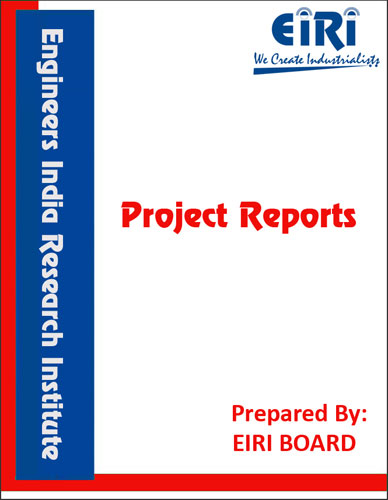The project report includes Present Market Position and Expected Future Demand, Market Size, Statistics, Trends, SWOT Analysis and Forecasts. Report provides a comprehensive analysis from industry covering detailed reporting and evaluates the position of the industry by providing insights to the SWOT analysis of the industry.
Anodizing is an electrolytic passivation process used to increase the thickness
of the natural oxide layer on the surface of metal parts. The process is called
anodizing because the part to be treated forms the anode electrode of an
electrical circuit.
Anodizing increases corrosion resistance and wear resistance, and provides better adhesion for paint primers and glues than bare metal. Anodic films can also be used for a number of cosmetic effects, either with thick porous coatings that can absorb dyes or with thin transparent coatings that add interference effects to reflected light. Anodizing is also used to prevent galling of threaded components and to make dielectric films for electrolytic capacitors. Anodic films are most commonly applied to protect aluminium alloys, although processes also exist for titanium, zinc, magnesium, niobium, and tantalum. This process is not a useful treatment for iron or carbon steel because these metals exfoliate when oxidised; i.e. the iron oxide (also known as rust) flakes off, constantly exposing the underlying metal to corrosion.
Anodising changes the microscopic texture of the surface and changes the crystalstructure of the metal near the surface. Thick coatings are normally porous, so a sealing process is often needed to achieve corrosion resistance. Anodised aluminium surfaces, for example, are harder than aluminium but have low to moderate wear resistance that can be improved with increasing thickness or by applying suitable sealing substances. Anodic films are generally much stronger and more adherent than most types of paint and metal plating, but also more brittle. This makes them less likely to crack and peel from aging and wear, but more susceptible to cracking from thermal stress.
Preceding the anodizing process, wrought alloys are cleaned in either a hot soakcleaner or in a solvent bath and may be etched in sodium hydroxide (normally with added sodium gluconate), ammonium bifluoride or brightened in a mix of acids. Cast alloys are normally best just cleaned due to the presence of
intermetallic substances unless they are a high purity alloy such as LM0.
The anodised aluminium layer is grown by passing a direct current through an electrolytic solution, with the aluminium object serving as the anode (the
positive electrode). The current releases hydrogen at the cathode (the negative build-up of aluminium oxide. Alternating current and pulsed current is also
possible but rarely used. The voltage required by various solutions may range from 1 to 300 V DC, although most fall in the range of 15 to 21 V. Higher
voltages are typically required for thicker coatings formed in sulphuric and organic acid. The anodising current varies with the area of aluminium being
anodised, and typically ranges from 0.3 to 3 amperes of current per square decimetre (20 to 200 mA/in²).
Aluminium anodising is usually performed in an acid solution which slowly dissolves the aluminium oxide. The acid action is balanced with the oxidation
rate to form a coating with nanopores, 10-150 nm in diameter. These pores are what allow the electrolyte solution and current to reach the aluminium
substrate and continue growing the coating to greater thickness beyond what is produced by autopassivation. However, these same pores will later permit air or
water to reach the substrate and initiate corrosion if not sealed. They are often filled with coloured dyes and/or corrosion inhibitors before sealing.
Because the dye is only superficial, the underlying oxide may continue to provide corrosion protection even if minor wear and scratches may break through
the dyed layer.
The most widely used anodising specification, MIL-A-8625, defines three types of aluminium anodising. Type I is Chromic Acid Anodising, Type II is Sulphuric
Acid Anodising and Type III is sulphuric acid hard coat anodizing
INTRODUCTION
TYPES OF ANODISING
TYPE-I(CHROMIC ACID ANODISING)
SPECIFICATION
CONSIDERATIONS FOR HARD ANODISING
MATERIALS:
PROPERTIES:
GENERATE CLEAR CRYSTALLINE COATINGS
INCREASE OF SURFACE HARDNESS AND ABRASION RESISTANCE
INCREASE CORROSION RESISTANCE
BENEFITS
ADVANTAGES
USES AND APPLICATIONS
B.I.S SPECIFICATION
MARKET SURVEY
COMPETITIVE ADVANTAGES
CHALLENGES
FUTURE GROWTH OF KITCHENWARE PRODUCTS
OVERVIEW OF INDIAN KITCHENWARE INDUSTRY
OVERVIEW OF METAL FINISHING AND KITCHENWARE INDUSTRY (GLOBAL)
EXPORT DATA OF KITCHENWARE
EXPORT OF KITCHENWARE (%AGE)
EXPORT DESTINATION OF KITCHENWARE
PRESENT MANUFACTURERS AND SUPPLIERS OF KITCHENWARE & COOKWARE SWOT ANALYSIS
PROCESS FLOW CHART
PROCESS OF HARD ANODISING
SURFACE PREPARATION
CHEMICAL CLEANING
THERE ARE TWO METHODS OF CHEMICAL ETCHING
ELECTROPOLISHING
CHEMICAL POLISHING
HARD ANODISING
RINSING
PLANT LAYOUT
SUPPLIERS OF RAW MATERIALS
HARD ANODIZING
CAUSTIC SODA
HYDROCHLORIC ACID
DEGREASING CHEMICALS
PACKING MATERIALS
SUPPLIERS OF PLANT AND MACHINERIES
HARD ANODISING PLANT
BENCH POLISHING MACHINE
EOT CRANES
DG SETS
POWER TRANSFORMERS
COOLING TOWER
AIR POLLUTION CONTROL EQUIPMENTS
AIR CONDITIONING EQUIPMENTS
AIR COMPRESSOR
PLATEFORM WEIGHING MACHINE
MATERIAL HANDLING EQUIPMENTS
FIRE FIGHTING EQUIPMENTS
SUBMERSIBLE WATER PUMP
APPENDIX – A:
1. COST OF PLANT ECONOMICS
2. LAND & BUILDING
3. PLANT AND MACHINERY
4. FIXED CAPITAL INVESTMENT
5. RAW MATERIAL
6. SALARY AND WAGES
7. UTILITIES AND OVERHEADS
8. TOTAL WORKING CAPITAL
9. COST OF PRODUCTION
10. PROFITABILITY ANALYSIS
11. BREAK EVEN POINT
12. RESOURCES OF FINANCE
13. INTEREST CHART
14. DEPRECIATION CHART
15. CASH FLOW STATEMENT
16. PROJECTED BALANCE SHEET



